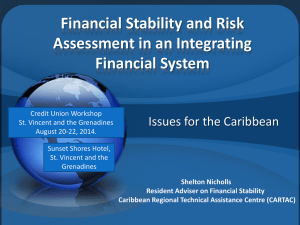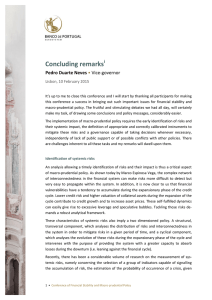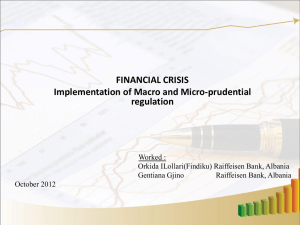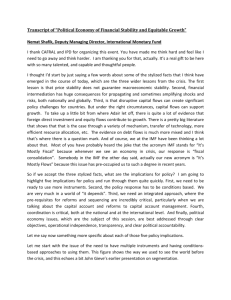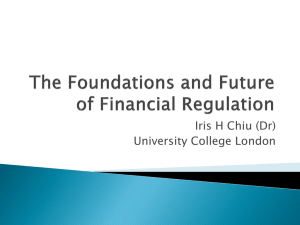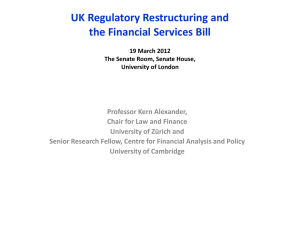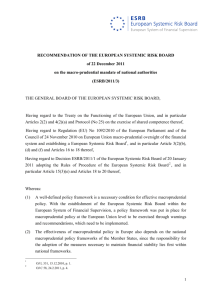An overall Evaluation
advertisement
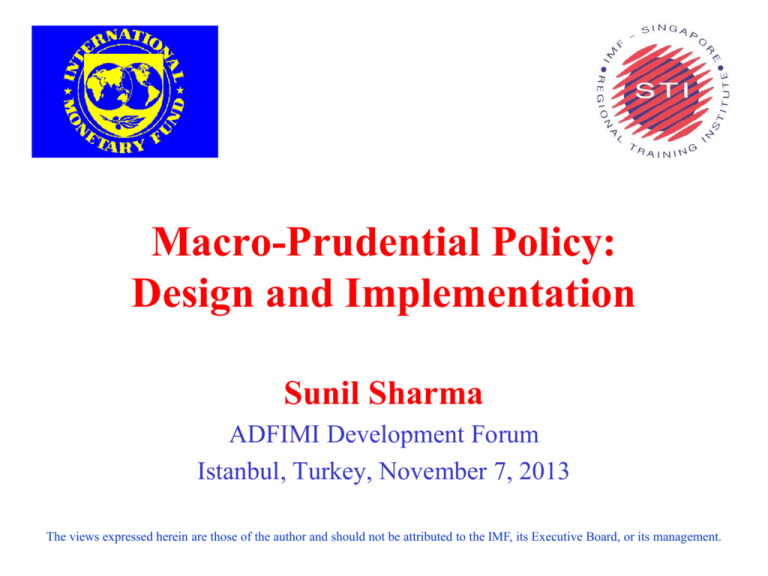
Macro-Prudential Policy: Design and Implementation Sunil Sharma ADFIMI Development Forum Istanbul, Turkey, November 7, 2013 The views expressed herein are those of the author and should not be attributed to the IMF, its Executive Board, or its management. Financial Stability and the Need for a New Policy Framework 2 Definition of Financial Stability Likely to have lasting financial stability when there is: 1.Monetary stability (or domestic price stability) 2.Employment close to economy’s “natural” rate 3.Efficient and smooth transfer of resources from savers to investors 4.Financial risks assessed and priced reasonably accurately, and relatively well managed 5.Confidence that financial system will be able to absorb real and financial shocks 3 Definition of Financial Instability Financial instability is a situation characterized by three features: 1. important financial asset prices seem to diverge sharply from fundamentals; and/or 2. market functioning and credit availability are significantly distorted, with the result that 3. aggregate spending deviates (or is likely to deviate) significantly, either above or below, from the economy’s ability to produce. 4 Financial Intermediation Households Governments Source: FSB Banks Securitization SPV Non-financial Businesses Households Hedge Funds ABCP Nonfinancial Businesses MMFs Broker Dealers (Interconnected via bank sponsorship, liquidity puts, repo markets, funding flows, securities lending) 5 Post Crisis: Need for a New Policy Framework • • • • • • • • • • • Pro-cyclicality Contagion in a highly interconnected financial system Price stability is not enough Market discipline is not enough Self-regulation has obvious shortcomings Risk concentration Risk mispricing and deficient risk management Distorted incentives and compensation structures Regulatory structures are never comprehensive Surveillance cannot be perfect Fiscal resources for government interventions 6 Interconnectedness Close symbiotic relationship between and among financial institutions and markets: • Banks increasingly rely on markets to obtain external funding, provide investments, and manage risks (through derivatives). • Markets rely on banks (and nonbanks) for market-making, back-stop liquidity services, and insurance. • Management of risks is predicated on liquid markets, and the growth of OTC instruments for trading risks. 7 Endogenous Risk • Risk generated and amplified by the system • Agents react to changes in the market, and their actions in turn may affect market prices and the financial environment • Role of market prices, especially for a financial system dependent on marketable assets • Banks and other financial institutions react based on price-sensitive incentive schemes and risk management systems 8 Desirable Features of a New Framework • Countercyclical • Symmetry between boom and bust phases of financial cycles • System-wide focus • Coverage of the entire financial system • Long horizon • Holistic approach 9 Macro-Prudential Policy 10 Policies and Objectives How we saw the world before the financial crisis Macro Macroeconomic Policies Price Stability Economic Activity Prudential Microprudential Policy Idiosyncratic Risk Policies and Objectives How we see the world now Macro - Prudential Macroeconomic Policies MacroPrudential Policy MicroPrudential Policies Price Stability Economic Activity Financial Stability Systemic Risk Idiosyncratic Risk What is Macro-Prudential Policy? Policies that limit systemic risk by dampening the build-up of financial imbalances building defenses that contain the speed and sharpness of downswings and their effects identifying and addressing common exposures, risk concentrations, linkages, and connections that are sources of contagion and spillover risks focusing on all banks, nonbanks, instruments, markets, financial infrastructure 13 Nature of Macro-Prudential Policy • Focus on systemic risk • Externalities leading to systemic fragilities – interconnectedness – strategic complementarities – fire sales of financial assets • Dampen effects of business & financial cycles • Time dimension: evolution of aggregate risk • Cross-sectional dimension: distribution of risks 14 Financial Stability Framework and Macro-Prudential Policy MONETARY CRISIS MANAGEMENT & RESOLUTION MICRO-PRUDENTIAL MacroPrudential Policy Tax & Structural Measures FISCAL & STRUCTURAL Source: IMF, Key Aspects of Macro-Prudential Policy (2013) COMPETITION Macro-Prudential Policy Framework Analytic framework (identification & monitoring of systemic risks; reporting requirements; data collection and analysis; assessment) Set of instruments (rules governing use; calibration; assessing policy effectiveness) Institutional architecture (structure, governance, coordination, transparency, accountability) 16 Macro-Prudential Policy: Design and Implementation 17 Macro-Prudential Policy Design • Combination of two kinds of policy strategies: Time-invariant regulation (baseline policies) Time-varying policies – Rules-based contingent on events – Discretionary • Rules based policy is difficult to design • Discretion opens the door to resistance 18 Macro-Prudential Policies BASELINE POLICIES Micro and Macroprudential regulations TIME-VARYING POLICIES Time-varying addition to baseline policies RULES-BASED DISCRETIONARY Pre-set rules trigger changes in policies Authorities decide when & how to change policies Hard to Measure Systemic Risk • “Tail events” and limited historical experience • Agglomeration of a variety of risks, and data collection from multiple sources & agencies • Endogenous nature of risk • Interlinkages and correlated exposures • No single framework for triggers and risk amplification mechanisms—non-linearities, threshold effects, Knightian uncertainty • No comprehensive operational definition • Difficulties of creating early warning systems 20 Operational Challenges for Rules-Based Time Varying Policy • • • • • Designing “actions” contingent on “events” Credible implementation when needed Ability to calibrate the macro-prudential toolkit Preventive actions based on a counterfactual Intermediate options: rules and markers as rough guides—rate of credit expansion, increases in property prices, growth of sectoral and economy-wide leverage 21 Discretion Opens the Door to Resistance • Uncertainty in risk measurement • Political and lobbying pressures – target a single or few sectors – coordination among several agencies: data collection, information exchange, analysis, decision making, implementation • Intellectual capture 22 Macro-Prudential Regulator? Council / Committee for MacroPrudential Regulation Central Bank (Monetary Authority, Liquidity Provider) Micro-Prudential Bank Regulator(s) (SIBs and non-SIBs) Markets Regulator Markets Regulator (Money, Capital, (Conduct of Business / Derivatives) Consumer Protection) Treasury / Ministry of Finance Other Regulators (Insurance, Competition, etc.) 23 Main Macro-Prudential Tools Agency Macro-prudential tools Central bank • Bank reserve requirements • Foreign exchange / reserve management Bank regulator • Capital requirements (systemic surcharges) • Liquidity requirements • Leverage requirements • Rules on maturity and currency mismatches • Collateral rules (e.g. LTVs) • Credit growth caps • Sectoral exposure caps • Disclosure regulations • Risk-based deposit insurance pricing • Bank resolution schemes (including living wills) • Accounting rules • Restrictions on compensation structures 24 Main Macro-Prudential Tools (contd.) Agency Macro-Prudential Tools • Restrictions on financial contracts • Collateral rules (e.g. margin requirements, haircuts) • Regulations on short-selling • Restrictions on trading venues (e.g. CCPs) • Trading stops (e.g. circuit breakers) • Disclosure requirements Market regulator • Regulation of financial contracts (e.g. terms of (consumer protection) mortgage contracts, DTIs) • Rules on selling strategies (e.g. information provision to customers) Market regulator (financial market) Treasury • Financial transaction and other taxes • Deductibility of interest payments on certain types of debt Insurance regulator • Regulation of systemically important insurers 25 The Macro-Prudential Decision Process Macroeconomic inputs hard and soft data Central Bank Financial sector inputs hard and soft data Bank Regulator Market Regulator Systemic risk analysis Central Bank Macro-prudential decision making Agency: ? Public communication Agency: ? Implementation Bank and Market Regulators, Central Bank, Other agencies 26 Challenges Related to Coordination • Information sharing, especially provision of soft information • Assessment of risks • Timing and calibration of interventions • Implementation, separation of decision making and control of instruments • Joint communication 27 Strong Baseline Policies Reduce Burden on Time-varying Policy • Robust institutions in normal times • Prevent or slowdown the creation of systemic risk • Structure of financial industry • Incentives created by organizational forms, activities, governance arrangements • Rules and regulations 28 Macro-Prudential Policy: Practice 29 Five Steps to Operationalize Macro-Prudential Policy Develop Capacity to Assess Systemic Risk Identify and Close Data Gaps Monitor & Close Regulatory Gaps Source: IMF, Key Aspects of Macro-Prudential Policy (2013) Select & Assemble Macro-Prudential Toolkit Calibrate Tools, Communicate with the Public and Markets Capturing the Financial Cycle: Some Useful indicators Macroeconomic indicators Broad credit aggregates Measures of debt sustainability (debt to income, debt service ratio) Banking sector indicators Stress tests, bank risk metrics Leverage ratios Maturity and currency mismatch Indicators of funding vulnerabilities Profits and losses Market-based indicators Asset valuations in equity and property markets Corporate bond and CDS spreads and risk premia Margins and haircuts Lending spreads Qualitative information Underwriting standards Asset quality Credit conditions CGFS, Paper #48, Dec 2012 Mapping Tools to Objectives: Structural Dimension Capital surcharge Increase resilience of Too-Big-To-Fail institutions Sectoral tools (within financial system : risk weights, limits on large exposures, …..) Reduce excessive exposures within the system Liquidity Tools Funding market Changes to market infrastructures Derivatives market Source: IMF, Key Aspects of Macro-Prudential Policy (2013) • Effective resolution regimes • Resolution plans • CoCos/Bail-in • Strengthened market infrastructure • Levies, fees, or taxes • Capital/liquidity surcharges • CoCos/Bail-in • Recovery plans • Disclosure • Intensive supervision • Compensation • • • • • Measures to reduce cost of failure Measures to reduce likelihood of failure Size Interconnectedness Complexity Lack of substitutability Global activity Identifying Systemically Important Institutions Measures to directly reduce systemic importance • Limitations on size and organizational structure • Restrictions on scope of activities Mapping Tools to Objectives: Time Dimension Countercyclical capital buffer & provisions Resilience to shocks Excessive Credit Growth Sectoral tools (sectoral capital requirements, limits on LTV and DTI ratios) Sectoral vulnerabilities to: Liquidity Tools Overexposure to funding shocks Source: IMF, Key Aspects of Macro-Prudential Policy (2013) Asset Prices, Exchange Rates, Interest Rates etc. Timing of Activation 1. Assessment of the building up of vulnerabilities and probability of a systemic shock 2. Uncertainty in the systemic risk assessment CGFS, Paper #48, Dec 2012 35 Effectiveness 3. Nature and robustness of links between changes in the instrument and the policy objective 4. Effect on expectations 5. Scope for leakages and arbitrage 6. Speed, flexibility and ease with which the instruments can be used CGFS, Paper #48, Dec 2012 36 Assessment 7. Costs of applying a macroprudential remedy 8. Uncertainty in the effects of the policy instrument 9. Optimal mix of macro-prudential tools to use CGFS, Paper #48, Dec 2012 37 Managing Capital Inflow Surges Exchange rate overvalued Lower Rates/ Reserves Adequate Intervene CFMs ≡ Capital Flow Management Measures CFMs Appreciate/ Lower Rates Appreciate/ Intervene + Sterilize Economy Overheating Source: IMF, Guidance Note For The Liberalization And Management Of Capital Flows (2013) Asian Experience with Macro-Prudential Tools Objective Manage Pro-cyclicality Tools Countercyclical provisioning Loan-to-value ratios Examples China; India China; Hong Kong SAR; Indonesia; Japan; Korea; Malaysia; Philippines; Singapore; Thailand Debt-service-to-income ratios China; Hong Kong SAR; Korea Tighter lending criteria China; Hong Kong SAR; Korea; Malaysia; Philippines; Singapore; Thailand Credit limits China; Hong Kong SAR; India Tighter supervision China; Hong Kong SAR; India; Korea; Malaysia; Singapore Capital requirements India; Malaysia Exposure limits on lending to specific sectors Korea; Malaysia; Philippines; Singapore Source: Morgan (2013) Asian Experience with Macro-Prudential Tools Objective Tools Manage Systemic Risk Capital surcharges for systemically important banks Examples China; India; Philippines; Singapore Liquidity and funding requirements China; India; Korea; Malaysia; Philippines; Singapore; Thailand Loan-to-deposit requirements China; Korea FX exposure limits Korea; Philippines Limits on currency mismatches Source: Morgan (2013) India; Malaysia; Philippines Institutional Structure 41 Evolution of Institutional Arrangements… • Rethinking institutional boundaries • Enhancing cooperation within existing structure • Separation of crisis prevention & management Mandate / Central Bank + Financial Supervision More integration Central Bank or Central Bank related committee Belgium, Ireland, UK Committee headed by Government No change in integration Malaysia, Thailand Chile, Mexico, Turkey, USA France 42 Central Bank vs. Macro-Prudential Council Advantages of Central Bank Advantages of Council / Committee Multiple tools: MonetaryMacro-Prudential interaction Coordination of monetary and Preventing conflicts of macro-prudential instruments interest; Joint “ownership” of policies Communication Coherence: one voice to the outside world Involvement implies interagency conflict less likely Information & Analysis Flow of “soft” information, if generated in house Diversity of views: preventing “group-think” Speed of action Greater decision speed Faster implementation, if many of the tools are outside central bank 43 Is There a “Preferred” Model? • No one-size-fits-all: Country specificities are important in building a macro-prudential policy framework: History of institutional arrangements and legal traditions Political economy considerations and cultural issues Availability of resources. • All models have strengths and weaknesses 44 Mechanisms to Address Weaknesses 1. Discipline use of power by independent agency 2. Dealing with separation of decision making from control 3. Reducing delays in decision-making 4. Fostering cooperation among agencies 45 Questions • What will convince skeptics that macroprudential regulatory structures will forecast and diffuse systemic risk? – Granular data and information – Better assessment of systemic risks – Design of rules and “markers” – Public conversation – Resources, personnel – Political will, enforcement – Track record. 46
